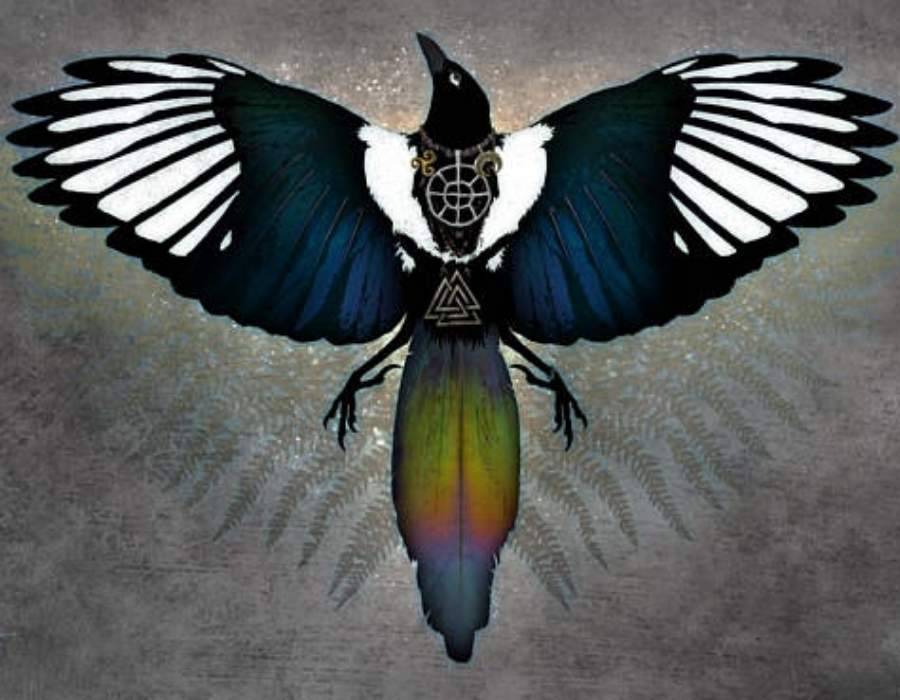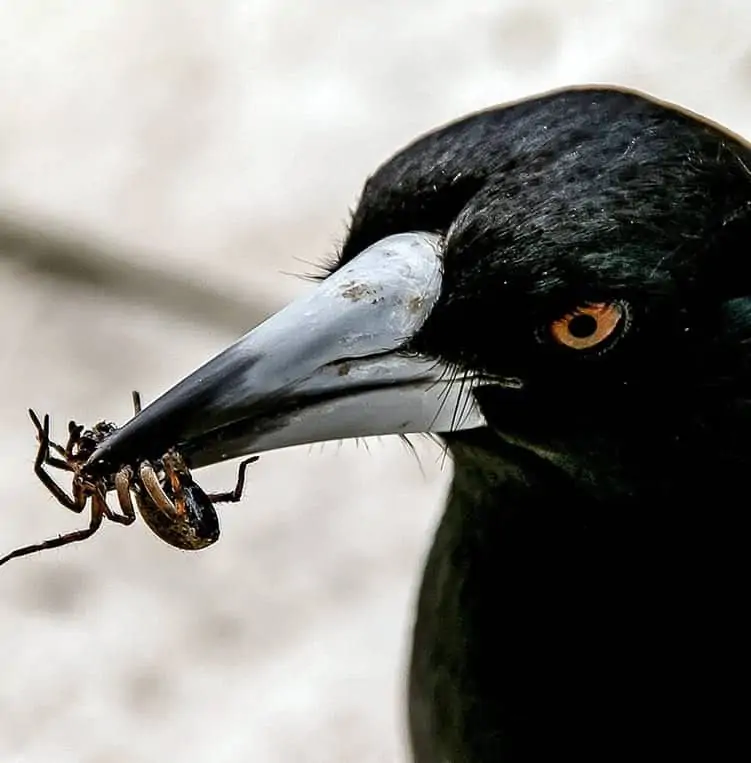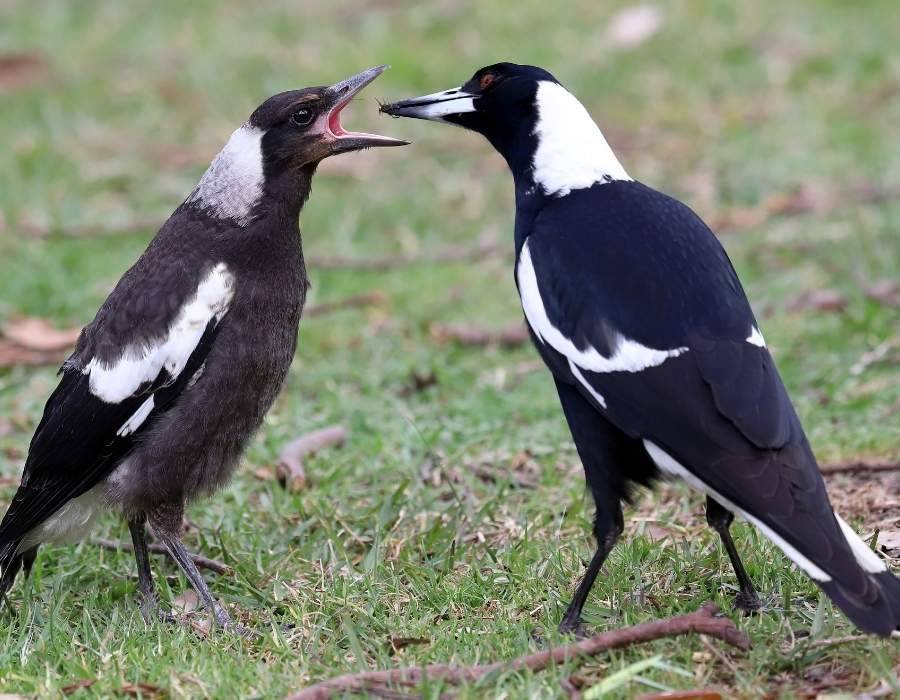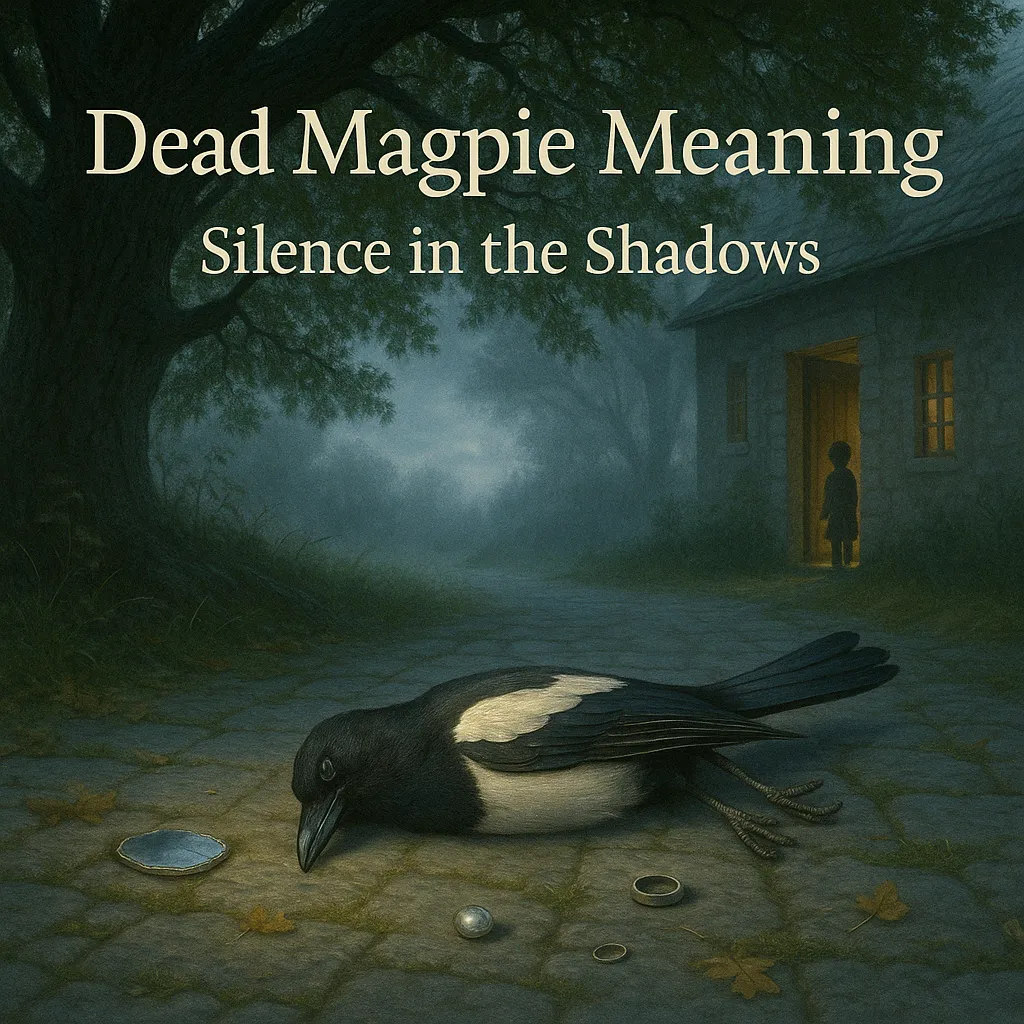Table of Contents
The veil between worlds thins when we encounter death in its raw, natural state. Finding a dead magpie—nature’s black and white messenger—often stops us in our tracks, creating a moment of profound presence. This striking bird, with its iridescent feathers catching the light even in death, carries potent symbolism that transcends cultures and epochs.
The dead magpie meaning resonates deeply in our collective consciousness, appearing in everything from ancient folklore to contemporary spiritual practice. Whether you’ve whispered the familiar “magpie saying” upon seeing one, or wondered about the message behind “1 magpie meaning,” these intelligent creatures serve as messengers between realms, offering wisdom that speaks to both endings and beginnings. Their death isn’t merely an ending, but a doorway to deeper understanding—if we’re willing to listen.
Key Takeaways
- Finding a dead magpie represents a powerful transition between life phases, inviting deep personal reflection and renewal.
- Across cultures, dead magpies function as spiritual messengers, carrying communications from ancestors and the divine.
- The black and white coloration of magpies symbolizes duality and balance, reminding us to integrate both shadow and light aspects of ourselves.
- Creating a personal ritual to honor a deceased magpie transforms a seemingly random encounter into a sacred experience of connection and meaning.
- Magpie symbolism varies widely across traditions, demonstrating how cultural context shapes our interpretation of omens and natural events.
The Spiritual Significance of Finding a Dead Magpie
Universal Symbols of Transition and Transformation
When we encounter a dead magpie, we stand at the threshold between worlds. These striking birds have long been recognized as messengers traversing the boundaries between the physical and spiritual realms. Their distinctive black and white plumage represents the fundamental duality of existence—light and shadow, life and death, conscious and unconscious. Indigenous cultures worldwide view the magpie as a sacred courier, delivering wisdom from ancestors and spirit guides.
Death itself carries profound symbolic weight, marking not just an ending but the necessary catalyst for new beginnings. The deceased magpie embodies this transformative power, offering an invitation to examine what must die within ourselves to make room for growth. Like the dead bird omen traditions found across cultures, the magpie’s passing signals completion of a cycle and the commencement of another.
The magpie’s contrasting coloration represents the integration of opposites—a visual reminder that balance emerges when we honor both light and shadow aspects of existence. This bird teaches us that wisdom comes from embracing life’s full spectrum, not just its comfortable dimensions.


What Does This Encounter Mean For You?
When a dead magpie appears in your path, consider the timing of this encounter. What were you thinking about just before? What life transitions are you currently navigating? The universe often speaks through synchronicities—meaningful coincidences that defy logical explanation.
Ask yourself these questions for deeper insight:
- What endings or beginnings am I currently experiencing?
- What message might my ancestors or guides be sending?
- What part of myself needs acknowledgment or release?
- How am I being called to balance opposing forces in my life?
Not every dead animal encountered carries spiritual significance. Trust your intuition—a hallmark of genuine spiritual messages is the resonance they create within. If you feel emotionally moved, curious, or inexplicably drawn to the experience, it likely carries meaning beyond random chance.
The Element of Divine Timing
The moment you discover a dead magpie may hold significance beyond coincidence. Many spiritual traditions teach that such encounters occur precisely when we need their specific medicine or message. Notice the phase of the moon, the season, and significant dates in your personal or cultural calendar.
Spring discoveries often relate to new beginnings emerging from apparent death, while autumn findings might emphasize release and preparation for inner work. Winter encounters frequently signal gestation of new ideas beneath the surface, and summer discoveries can represent the fullness of life’s cycles.
The moon’s phase adds another layer of meaning—new moons amplify themes of fresh starts and intention setting, while full moons illuminate hidden truths and bring emotional culminations. The cosmic timing of your magpie encounter weaves into its overall message, creating a tapestry of meaning unique to your life’s current chapter.


Magpie Symbolism Across Cultural Traditions
Native American Perspectives
Among many Plains tribes, magpies hold sacred status as messengers between worlds. The Cheyenne and Lakota recognize these birds as wisdom keepers who travel freely between physical and spiritual realms. When a magpie dies, these traditions teach that its spirit carries specific guidance from ancestors to the living.
Traditional burial rituals for magpies involve cedar—a purifying element believed to assist the bird’s spirit in its journey. Many tribes honor deceased magpies by gently wrapping them in cedar boughs before returning them to the earth, facing eastward toward the rising sun, symbolizing renewal and continuation.
The magpie also embodies the trickster archetype in many Native traditions, akin to Coyote or Raven. This spiritual energy brings necessary disruption, using clever means to teach profound lessons. The death of a magpie might indicate that a transformative lesson awaits—one that may initially appear as loss but ultimately leads to greater wisdom.
Celtic and European Folklore
Perhaps the most famous magpie lore comes from British tradition, captured in the counting rhyme that begins “One for sorrow, two for joy.” This rhyme, dating back centuries, reflects deep cultural associations between magpies and fortune. Finding a single dead magpie was considered particularly portentous, requiring specific rituals to ward off misfortune.
Medieval European beliefs connected magpies with death due to their scavenging nature. Their presence on battlefields and plague sites created associations with the transition between life and death. In Irish tradition, magpies were sometimes considered manifestations of the Morrígan—the goddess of battle, fate, and death—carrying souls to the otherworld.
Scottish folklore teaches that magpies near the home signify impending visitors or news from distant sources. A dead magpie discovered near one’s dwelling might indicate that important news has been intercepted or delayed—a message that failed to reach its intended recipient.
East Asian Spiritual Interpretations
Chinese tradition holds magpies in particularly high regard, considering them harbingers of good fortune and joy. The birds appear in countless artistic representations, symbolizing happiness and marital bliss. When a magpie dies, Chinese folk tradition sees this as a temporary disruption in fortune’s flow—a signal to examine one’s actions and make necessary adjustments.
In Japanese Shinto practice, birds serve as messengers (shinshi) between humans and kami (divine spirits). The death of a magpie might represent an intensified message from the spirit world—one so important that the messenger sacrificed its physical form to deliver it.
Korean folklore associates magpies with the bridge between worlds, particularly in ancestral communication. Finding a dead magpie might indicate an ancestor urgently seeking connection, perhaps to offer guidance during challenging transitions or to acknowledge important life events.
Modern Pagan and Wiccan Views
Contemporary pagan traditions often incorporate magpie symbolism into practices centered on divination and transformative work. Many Wiccans view the magpie as a liminal creature—one that traverses boundaries and brings messages from the divine.
Some modern practitioners create altars honoring deceased magpies, incorporating their feathers (where legally permitted) into rituals focused on communication with spirit guides or ancestors. Black and white candles may represent the duality embodied by the magpie, while reflective objects honor their attraction to shiny items.
Shadow work—the psychological and spiritual practice of confronting repressed aspects of self—often incorporates magpie symbolism. The bird’s death may signal readiness to examine previously avoided emotional territory, inviting integration of fragmented aspects of consciousness. This psychological alchemy transforms personal darkness into wisdom, much as the magpie navigates between light and shadow.


Dead Magpie in Dreams and Visions
Interpreting Dream Visitations
Dreams featuring dead magpies carry potent symbolic weight, often emerging from the deepest layers of consciousness. These dreams may signal approaching life transitions or the need to confront unacknowledged truths. Unlike encounters in waking life, dream magpies arise from your own psyche, making their messages particularly personal.
Pay attention to the dream’s emotional tone and context. A peaceful scene with a deceased magpie might indicate natural completion and acceptance of endings. Disturbing imagery suggests resistance to necessary change or unprocessed grief. Recurring magpie dreams signal persistent messages requiring attention—wisdom repeatedly attempting to break through conscious barriers.
Keep a dream journal dedicated to animal messengers, noting details like the magpie’s condition, surrounding environment, your emotional response, and any words or messages received. Over time, patterns may emerge, revealing deeper layers of meaning connected to your personal journey and the specific medicine magpie brings to your life.
Meditative Visions and Spirit Communication
Intentional meditation can deepen your connection with magpie wisdom. Create a quiet space free from distractions, perhaps incorporating a feather or image of a magpie as a focal point. Begin with grounding exercises to center yourself, then visualize meeting the spirit of the magpie you encountered.
When receiving guidance through meditation or visionary experiences, distinguish between fear-based projections and authentic wisdom. True spiritual messages typically feel clarifying rather than confusing, empowering rather than diminishing. They often carry an unmistakable resonance that transcends ordinary thought.
Before attempting deep communication with magpie energy, establish sacred space through whatever practice aligns with your spiritual path—whether smudging with herbs, casting a circle, or simply setting conscious intention. This creates energetic boundaries that support clear reception while honoring the profound nature of cross-realm communication.
Shadow Work Through Magpie Symbolism
Carl Jung, the pioneering psychologist, recognized birds as potent symbols of the unconscious mind. Dead magpies can represent aspects of self that have been denied expression—parts that must “die” symbolically before being reintegrated in healthier forms. Their black and white appearance perfectly embodies the shadow/light dichotomy central to Jung’s work.
Working with magpie death symbolism might involve journaling about qualities you repress or deny, meditating on dualities in your nature, or creating art that explores personal shadows. This process isn’t always comfortable, but it leads to greater wholeness and authentic expression.
Integration practices might include:
- Creating a personal ritual acknowledging aspects of self you’re ready to transform
- Writing dialogues between your conscious self and the magpie as representative of your shadow
- Exploring polarities in your nature through movement, art, or sound
- Recognizing how “negative” traits might contain hidden gifts when acknowledged and transformed


What To Do When You Find a Dead Magpie
Honoring Practices from Various Traditions
When encountering a deceased magpie, you can draw upon diverse cultural practices to honor this messenger. Native American traditions often employ a cedar burial ritual: gently wrap the bird in cedar branches (known for purification properties), offer tobacco or cornmeal as gifts to the spirit, and return it to the earth facing east—the direction of new beginnings.
Celtic traditions suggest acknowledging the magpie with respect through simple warding chants like “Good morning Mr. Magpie, how is your lady wife today?” Even when addressing a deceased bird, this traditional greeting honors the magpie’s spirit. Some practitioners leave small offerings of shiny objects, berries, or grain nearby as tokens of respect.
East Asian practices include burning small amounts of incense near the magpie while offering prayers for its journey onward. In Chinese traditions, placing a red thread near the bird symbolizes continued connection between realms and helps guide the magpie’s spirit toward beneficial rebirth or transformation.
Creating Your Own Mindful Response
Personal rituals hold power when created with sincere intention. Begin by taking a moment of stillness, acknowledging the significance of this encounter. Express gratitude for the magpie’s message, even if its meaning isn’t immediately clear. This conscious pause transforms a random event into a sacred moment.
Consider these ethical guidelines when handling deceased wildlife:
- Wear gloves if you need to move the bird
- Respect local regulations regarding wildlife handling
- Never take parts from protected species
- If collecting is permitted, take only what you’ll use meaningfully
Photography offers a non-intrusive way to honor the encounter while creating a visual record for reflection. Some spiritual practitioners create artwork inspired by the experience—poems, paintings, or small altars incorporating natural elements that commemorate the magpie’s message without disturbing its physical form.
Practical Considerations and Precautions
While honoring spiritual significance, prioritize safety when handling deceased wildlife. Always use gloves, wash hands thoroughly afterward, and avoid touching your face during the process. If the bird shows signs of disease or unusual circumstances surrounding its death, contact local wildlife authorities rather than handling it directly.
In many countries, magpies receive protection under wildlife conservation laws. The Migratory Bird Treaty Act in the United States prohibits collection of magpie feathers, eggs, or body parts without proper permits. Similar regulations exist in Australia, Canada, and throughout Europe. Always research local regulations before collecting any part of a deceased magpie.
If you find a magpie that appears recently deceased without obvious injury, consider reporting it to local wildlife authorities, especially if multiple birds are found. This could indicate environmental hazards, disease outbreaks, or other issues requiring professional attention for wildlife conservation purposes.


Magpie Omens: Myths vs. Spiritual Wisdom
Common Superstitions Decoded
The practice of “saluting a lone magpie” emerges from the belief that a single magpie brings sorrow. This superstition, popularized through the counting rhyme “One for sorrow, two for joy,” prompted people to greet solitary magpies respectfully to avert misfortune. Rather than simple superstition, this practice represents acknowledgment of the bird’s spiritual significance and the human desire to maintain harmony with natural messengers.
Fear-based interpretations of magpie encounters often reflect historical circumstances rather than inherent spiritual truth. During Europe’s plague years, magpies scavenged infected areas, creating associations with death. Similarly, agricultural communities viewed them as crop pests, further cementing negative perceptions. Understanding this context helps separate cultural bias from deeper spiritual wisdom.
Many beliefs surrounding dead magpies originated during times when unexplained natural phenomena required interpretation through available cultural frameworks. Today, we can appreciate these traditions while recognizing the difference between superstition born of fear and spiritual symbolism emerging from respectful observation of nature’s patterns.
Reframing Cultural Interpretations
Modern spiritual practice invites us to move beyond superstition toward meaningful relationship with natural symbols. Rather than asking “Is this good luck or bad luck?” we might instead consider: “What wisdom does this encounter offer?” This shift transforms passive superstition into active spiritual engagement, honoring both ancestral traditions and personal intuition.
Fear-based interpretations persist partly because they align with our brain’s negativity bias—our tendency to give greater weight to negative experiences and information. Throughout human evolution, this bias helped us survive by remaining alert to potential threats. However, spiritual growth often requires consciously expanding beyond this limitation to embrace more nuanced understanding.
Many contemporary practitioners reclaim magpie symbolism by researching cross-cultural perspectives, meditation with the bird’s energy, and personal experience. This approach honors traditional knowledge while creating space for direct spiritual connection beyond cultural constraints or historical limitations.
Magpie Intelligence and Spiritual Consciousness
Scientific research reveals magpies as extraordinarily intelligent birds capable of self-recognition in mirrors—a rare cognitive ability shared by only a few species including great apes, dolphins, and elephants. This self-awareness suggests a level of consciousness that supports traditional views of magpies as spiritually significant messengers.
Studies have documented “magpie funerals” where groups gather around deceased community members, sometimes placing grass sprigs near the body before departing. This behavior indicates sophisticated social cognition and potentially ritualistic practices that mirror human mourning. Such observations bridge scientific understanding with spiritual traditions about magpies’ connection to death rites and ancestral realms.
The magpie’s renowned intelligence—including tool use, complex social structures, and remarkable memory—connects to their spiritual symbolism as messengers between worlds. Their cognitive abilities suggest capacity for awareness that transcends ordinary consciousness, aligning with traditional roles as intermediaries between physical and spiritual dimensions.
FAQ
What is the 1 magpie meaning in spiritual traditions?
A single magpie traditionally symbolizes sorrow or temporary misfortune in Western folklore, while in Eastern traditions it may represent solitude and self-reflection. Spiritually, one magpie often signals a message from ancestors or the need to prepare for significant change. This solitary messenger invites deeper awareness of life’s dualities.
What does the 2 magpie meaning represent symbolically?
Two magpies symbolize joy, harmony, and positive partnerships across many traditions. This pairing represents balanced energy and successful collaboration. In spiritual practice, seeing two magpies suggests that current projects will flourish through cooperation. Some traditions view this as confirmation that ancestors approve of your current path.
What is the magpie in garden meaning from a spiritual perspective?
A magpie visiting your garden brings messages about growth and personal territory. Gardens represent cultivated aspects of life, so magpies appearing here often relate to relationships and projects you’re nurturing. They may indicate the need to protect your boundaries while remaining open to unexpected wisdom that appears in your carefully tended spaces.
What is the spiritual meaning of magpies visiting repeatedly?
Repeated magpie visits suggest persistent messages requiring attention. These consistent appearances indicate that spiritual guides are emphasizing important lessons you haven’t fully integrated. Notice the timing, number, and behavior of visiting magpies for deeper insight. This pattern often precedes significant life transitions or spiritual awakenings.
What does magpie in house meaning signify across cultures?
A magpie entering your home represents threshold crossing between worlds. Many traditions view this rare occurrence as an important omen requiring immediate attention. In Chinese folklore, it brings unexpected good fortune, while European traditions suggest imminent news from distant sources. The message intensifies if the bird appears in unusual rooms.
Are magpie feathers lucky to find and keep?
Magpie feathers are considered powerful spiritual tools in many traditions, though legal restrictions often apply to collection. Their dual coloration represents balance between worlds, making them valuable for divination and protection work. Check local wildlife laws before collecting, as many countries protect these birds under conservation legislation.
What is the spiritual significance of finding a magpie feather?
Finding a magpie feather without seeking it represents a gift from spirit. These feathers traditionally facilitate communication between worlds and assist in truth-seeking. The specific meaning varies based on the feather’s condition, coloration, and the circumstances of finding it. Many practitioners use these feathers in meditation to enhance intuitive abilities.
What is the traditional magpie saying and its spiritual meaning?
The traditional rhyme “One for sorrow, two for joy…” originated as a divination tool based on magpie counting. Beyond simple fortune-telling, this saying acknowledges magpies as messengers whose numbers carry specific vibrations. The complete rhyme continues with specific meanings for encounters with three through seven birds, creating a complete symbolic system.


